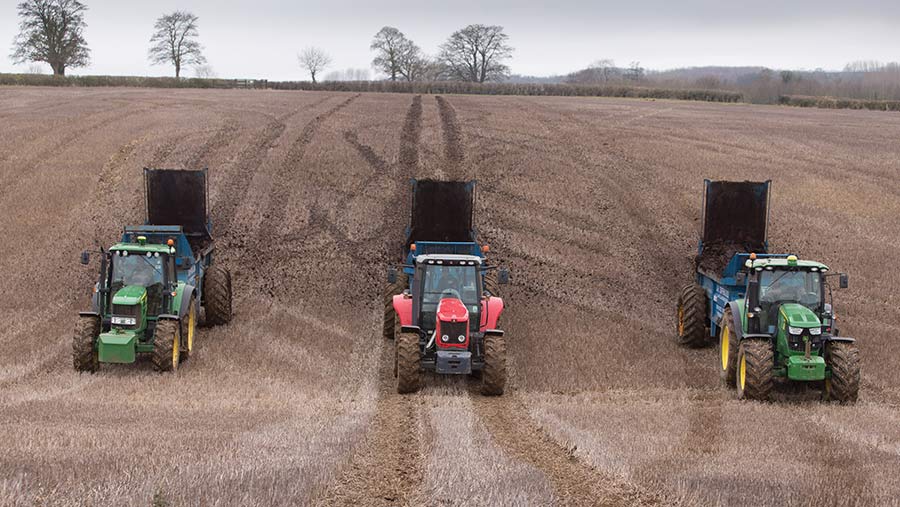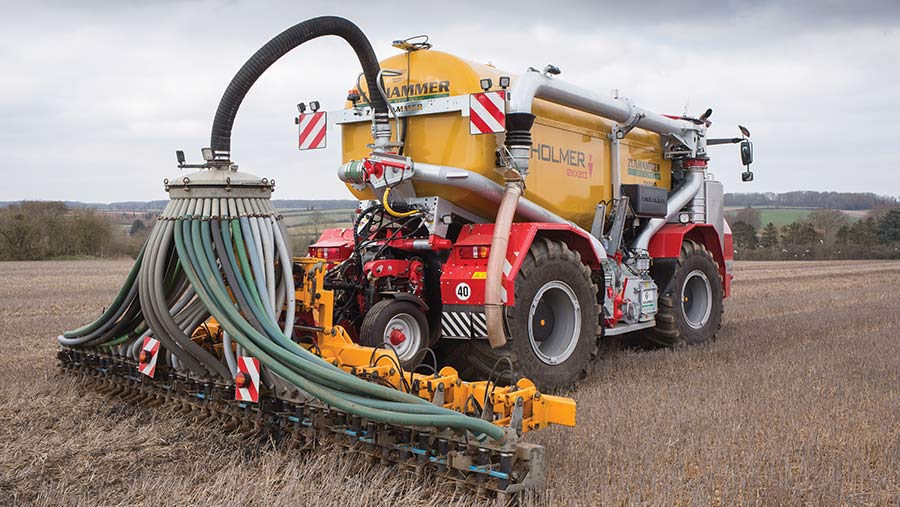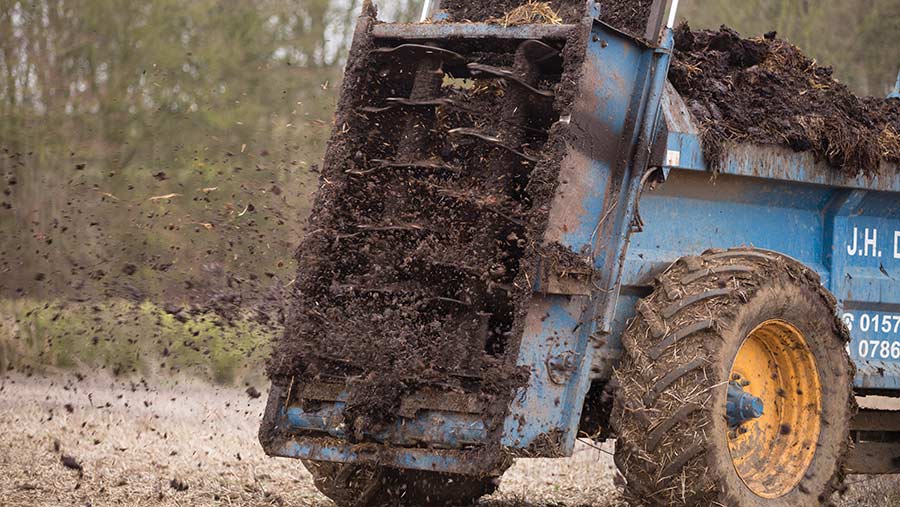Big savings in fertilisers can be made by utilising manures
 © Tim Scrivener
© Tim Scrivener Arable growers are being urged to make better use of organic manures to save them up to nearly £400/ha on their annual bagged fertiliser bills, while also needing to take actions to limit nitrate leaching and ammonia emissions.
The use of these products, from farmyard manure to biosolids, could also increase soil organic matter, which will help improve soil structure, resilience in dry weather, and lead to an increase in yields.
See also: How to move towards nitrogen self-sufficiency in a regen system
Nutritional values
John Williams, soil scientist at crops consultant Adas, says these organic materials are a valuable source of crop nutrients, especially if actions are taken to limit losses from leaching, volatilisation and de-nitrification.
He advises growers to assess what nutritional values these manures contain, what nutrients their crops need, and the best timing of applications to work out a crop nutrition plan for the farm.
A good starting point is to use Defra’s fertiliser bible RB209 to give the nutrient value of manures. This can be backed up for more detailed results from laboratory analysis.
On heavier soils, farmyard manures – which are slower to release nutrients to crops than liquid manures – are often best applied after harvest and ahead of a crop which has a big nutritional need.
“If applying in the autumn, target crops with a good autumn requirement, such as oilseed rape,” John says.
He adds that pig manure applied at 30t/ha has the best saving of bagged fertiliser, worth £372/ha, just ahead of 8t/ha of poultry manure, worth £349/ha.
These two are followed by 20t/ha of biosolids worth £251/ha, while whole digestate at 25t/ha is worth £157/ha, and cattle slurry applied at 35t/ha some £142/ha.
The key is to decide what nitrogen is readily available to the crop, add a value for some mineralisation of nitrogen, and then minus estimated losses to give a value for crop-available nitrogen. This works out how much bagged fertiliser top-up is needed.
However, different organic manures provide nitrogen at different release rates. Pig and cattle slurry have the most nitrogen readily available to crops, while cattle manure and biosolid cake are the slowest to release available nitrogen.
John points out that 20% of a highly-available source, such as slurry or poultry manure, would be leached away in a September application for an autumn-sown crop, while the figure for slower-releasing farmyard manure would be only 7%.
Therefore in general, farmyard manures used on heavy land are best applied in autumn, and faster-acting liquid manures in the spring, on light sandy land if ground conditions allow, he says.

© Tim Scrivener
Ammonia emissions
Minimising losses from ammonia volatilisation can be more difficult, but are critical to cut as 85% of the total UK ammonia emissions come from farming.
The key is to reduce the manure’s contact with the air by soil injection or soil incorporation, and make more of the ammonia available to the growing crop.
He suggests using slurry bandspreading or shallow injection to reduce ammonia losses and odour nuisance with liquid manures. This will give an added benefit of spreading the slurry very evenly across a field.
Using a shallow injection system, ammonia losses can be cut by 70%, while a trailed shoe machine can cut losses by a lower 40% and a trailed hose by 30%.
Solid manures need to be incorporated as soon as possible (preferably within six hours) by either ploughing or shallow cultivations to 75-100mm to cut ammonia emissions. This is difficult to achieve under a direct-drilling situation.
The top nitrogen-supplying pig manure is also rich in phosphates and potash, and at 30t/ha could supply 25kg/ha of N, 210kg/ha of P and 280kg/ha of K.
For an oilseed rape needing N-P-K of 190-50-40 kg/ha, this would supply enough P and K to feed subsequent crops.
A further benefit of using organic manures is soil health, as it gives an improvement in soil structure, water holding capacity, biological activity, retention of crop nutrients and resilience in dry weather.
Farmyard manure applied over 20 years and green compost applied over nine years led to a 20-25% increase in a soil’s organic matter, compared with 20 years of livestock slurry which only saw a rise of 5-10%.
Although the green compost performed better in a shorter timescale, the manure produced the best topsoil biomass, or amount of biological activity, explained by the fact that carbon is lost in the composting process. With manure, all carbon is incorporated into the soil.
The financial benefit in terms of yield can be seen by the use of farmyard manure at 40t/ha/year in a 10-year plus trial on sandy soil at Harper Adams University. It gave a yield lift in potatoes of 1.5t/ha, worth £225/ha, and a 0.78t/ha lift in carrot yields, worth £120/ha, on the sandy soils at the Shropshire university.

© Tim Scrivener
On-farm results
Father and son AHDB Monitor Farm operating team Andrew and Sam Melton are using biosolids on the 1,400ha they farm in north-west Norfolk as the levy board’s Wisbech Monitor Farm.
They usually spread biosolids across 100-150ha of land a year, when available, before oilseed rape, second winter wheats or sugar beet. It is then incorporated into the soil, leading to a saving in bagged fertiliser.
“We are definitely seeing the benefit in terms of cost reductions and organic matter gains.
“The biosolids give us a good phosphate supply for our soils, which are generally low in phosphates,” says Andrew.
They are also growing 4-5 species of cover crops before all spring crops, such as spring barley, spring beans and sugar beet.
Although they have not cut back on fertiliser for cash crops grown after cover crops, they are seeing better crop rooting and soil drainage, and their soils are showing an improved capacity to hold crop nutrients.
The farm is also growing companion crops with oilseed rape, which gives a lot of benefits in terms of diversity and soil health, and some control of cabbage stem flea beetles.
The business at Peartree Farm, Walpole Highway, just four miles North East of Wisbech, is looking to reduce tillage on its silty clay loams.
Despite using minimum tillage and some ploughing, they are still looking to reduce tillage further.
Cropping includes winter wheat, winter barley, oilseed rape, and spring-sown crops of beans, barley and sugar beet.
The cover and companion cropping to improve the soils will qualify for environmental schemes such as the Sustainable Farming Incentive (SFI), which the farm is in the process of joining.
Under the SFI, cover crops pay £129/ha/year in SAM2, while companion crops pay £55/ha/year under IPM3.
All the speakers were attending an AHDB Wisbech Monitor Farm meeting in December 2023 entitled “Evaluating alternatives nutrition sources”.
